by Gina Ronning
OK radicals–it’s time to sit down and have a serious conversation on what it means to have strategy and tactics in a political action. First, for those more timid about challenging the status quo I feel it imperative to remind our citizenry that despite local ordinances the right to peacefully assemble absent of a permit or fee is a constitutional right. If the powers that be have changed the law so that this is not the case, then in terms of nonviolent struggle this would be considered an unjust law in which we are rightful, if not dutiful to challenge.
The purposes of this post is not to get in to semantics over what defines a radical or not, however, let’s be clear about one thing: there are parades, and then there are protests. A call for a diversity of tactics implies that both of these are good and needed, and each serves to fulfill different needs for different groups. The parade is a community-building event, it shows solidarity, unity and in large numbers its very presence can have a tremendous impact over particular political and social outcomes. Very little strategy is required for such an event, as it is bought, paid for and organized by both the community and the State.
Protests on the other hand, directly seek to engage with very specific unjust laws and or practices. Protests are not safe, simply because there will always be an inherent risk when any form of direct confrontation occurs, particularly between activists and institutions of power. Nonviolent struggle doesn’t mean the absence of violence, it refers to the willingness to accept the risk of such violence brought on by the oppressors as we seek to engage and have our voices heard, as well as the willingness to refrain from committing acts of violence towards the oppressor. Whether one agrees with this philosophy or not is a separate debate, the point I am making is that we must not confuse the nature of parades and the nature of protests.
By nature, “the protest” seeks to disrupt the status quo. Therefore, any law, policy or ordinance, which would seek to minimize this disruption, will forever be at odds with its constitutionality and the reasons why “the protest” even exists! The state will always seek to defend and preserve its own interests, and “the protest” will always seek to disrupt these interests. For us “radicals” the concept of obtaining a permit to create such a disruption is not only counterproductive, but endangers the foundations of freedom and democracy. First, the desire and ability to march in the streets without a permit is NOT a radical idea, but it is made out to be so by those who would seek to be disrupted by actions that are indeed clearly intended to disrupt the daily routine of the system. Secondly, criminalizing acts of democracy (such as marching without a permit) is the exact type of tactic used by power to de-legitimize causes of social justice.
The radical march on May Day was only radical in the sense that we intended to exercise our freedom despite the risk of excessive use of force and abuse by Portland Police. With that being said, if we are going to engage in protests which seek to challenge the issue of permitted versus unpermitted, we must also be willing to engage in coordinated strategies and tactics that will bring fruitful results of such actions. This did not happen on May Day for this specific action.
Perhaps it is a general lack of knowledge, a generational gap, perhaps it is the level of mistrust and/or the paranoia that permeates all forms of security cultures? What ever it is, the knowledge on how to conduct effective and strategic street maneuvers has clearly been misplaced among “radicals”. I consider myself a radical, so here it goes…
As I reflect on the events surrounding the “radical” un-permitted march, I witnessed many things. Some observations were hopeful and uplifting. I saw unity and collaboration among a diverse group of individuals in moments of high intensity. What was clearly lacking however was an understanding of how to maneuver and engage with police formations. There was also a lack of willingness, and or responsiveness on behalf of what some might refer to as ‘organizers’ to include a diversity of tactics, and in diversity of tactics I am referring to the coordinated strategies involving tactical march formations and responses. I really believe that this was not due to a lack of interest, but rather a lack of knowledge and experience. Most people were afraid and unclear on what to do, while others were over reactionary and instead of being strategic allowed emotions to flow in a manner, which resulted in needless arrests and unnecessary confrontations.
Police were intense as usual — this is nothing new. Their approach was classic, and predictable, and represented the exact same response they always have. On cue one could predict how many would arrive, when, where and how they would employ, and yet despite this predictability, protesters were surprised and caught off guard each time. This is a very fixable issue but it requires skill, discipline, control and leadership. Leadership for me is not a dirty word, particularly when it can come in a variety of forms, even if only in a unified understanding of a tactical plan, and those willing to assist in its fruition.
Effective street tactics require calm in the eye of the storm. It requires coordination, and the restraint of knee jerk reactions. It requires the employment of well thought out tactical maneuvers, which disarm and disrupt the usual response of state control. It’s not about being antagonistic, it’s about achieving the desired goal. It is also about expending the least amount of energy and resources as possible. You don’t have to be a great military strategist, but at the very least, you need to know your goals, your tools, your participants, your environment, and your obstacles.
There are many definitions of what it means to be “radical”. For some it means dressing in black, and taking on the persona of the famed black bloc approach. However if one wants to take on this persona, it might suit them well to actually be trained and knowledgeable in black bloc strategy, and also have the ability to facilitate this action among others who are not knowledgeable. To be radical is not in the color of clothes you wear, or in your level of disdain for the system, how loud you can yell at the police, but in how one engages with the status quo to achieve the desired results.
Inexperience and lack of knowledge in direct actions and or protests, and taking others in to a situation of direct confrontation with police is irresponsible and needlessly jeopardizes activists and community members, not to mention its complete ineffectiveness in getting desired results, such as maintaining an entire march route without being bullied by the police. For a march that was intended to be “radical” we spent most of our time on the sidewalks, if I wanted to do this I would have chosen the parade.
Since I am not one to complain without taking action, I will be organizing a workshop on what I will call “Radical Geometry”. I welcome collaborators who have knowledge to share. This form of knowledge needs to be shared. Find me if you’re interested, or come to the workshop, or do a workshop of your own. It will get posted on all known calendars and will happen sometime in late May or very early June. I am no expert in the traditional sense of the word, but my years as an activist and observer have equipped me with what I consider to be basic street smarts, and simple yet effective formations, maneuvers, and tactics that can assist any activist who wishes to exercise their freedom of speech absent of governmental/corporate fees and permission. We must empower our community to not only engage in actions, but to engage in them well informed. This isn’t about being radical: it’s about being effective.

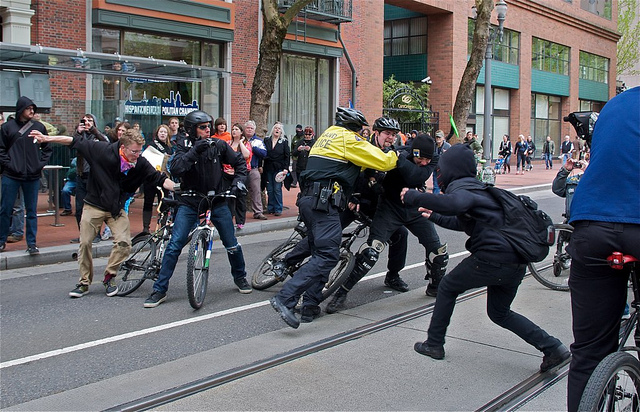

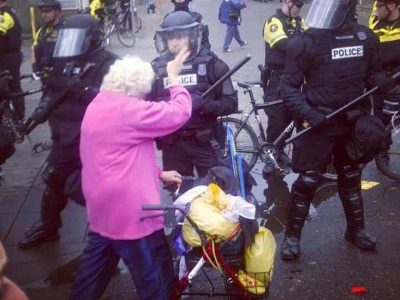
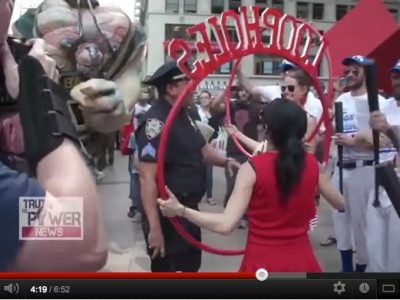
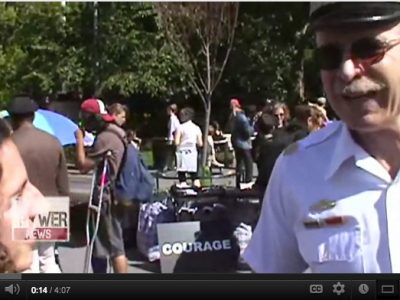

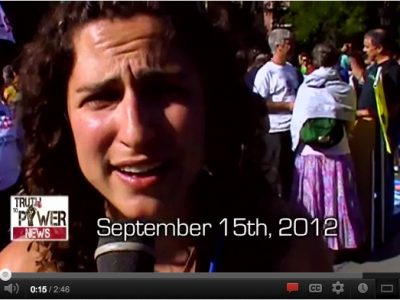
10 comments for “Radical Geometry: A Constructive Critique of the Radical March on May Day”